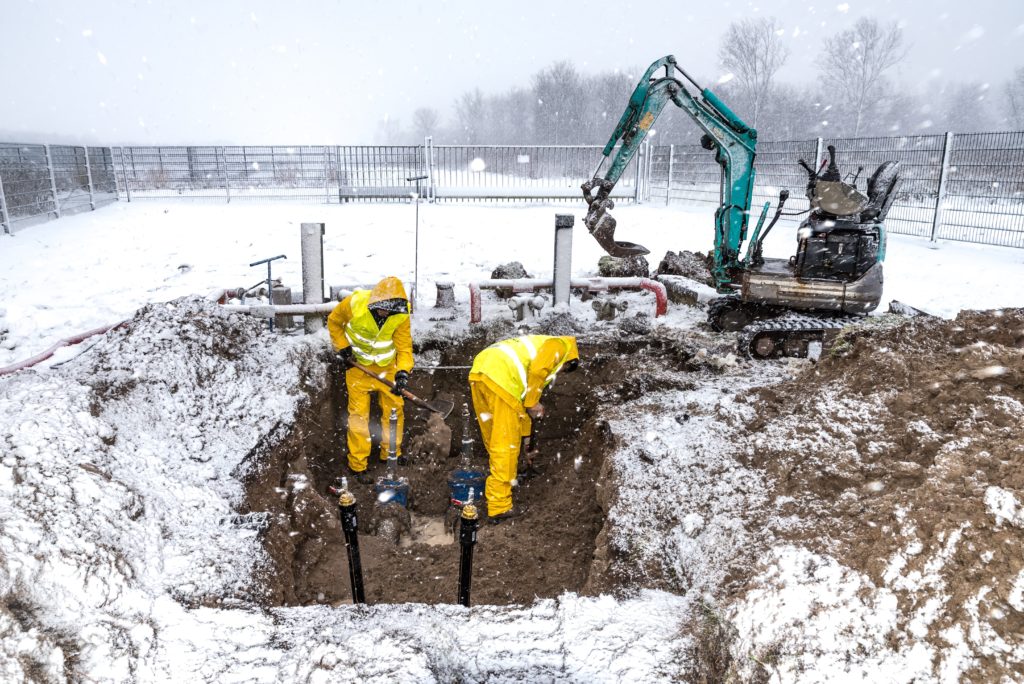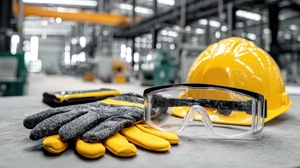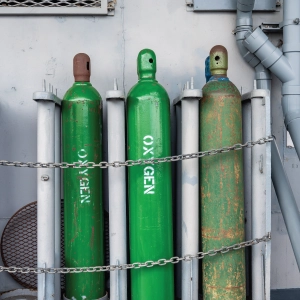Winter Safety for Construction Workers

As winter approaches, the hazards faced by workers in the construction industry increase due to prevailing wet and cold weather conditions adding a new layer of danger to everyday work tasks. So, what are these added dangers faced by workers during the winter season? And why is winter safety an important consideration in the construction industry?
Importance of Winter Safety
Winter weather brings us snowfall, low temperatures, winter storms, and ice buildup in worksurfaces and equipment. While there is a feel of a ‘winter wonderland’ with towns, buildings, gardens, and trees covered in clean white snow, there is also an inherent danger. These dangers, which include snowstorms, blizzards, the buildup of snowdrifts, ice formation, wetness seeping through clothes, and melting snow causing flooding and water puddles in unexpected places are a cause of hazardous work conditions, especially for people employed in the construction industry. These construction industry workers will be faced with icy roads and pathways, snow piled on worksites and partly completed buildings, frozen pipes, downed powerlines, snow or ice on equipment and work surfaces, scaffolding being covered in snow and ice, and many other similar problems that could not only increase the risks to health and safety while carrying out their work tasks but result in creating new types of safety and health hazards such as frostbite. Working in the cold can also be more physically hindering for workers who must wear bulkier and added protective clothing to protect against freezing temperatures and cold winds. Thus, winter safety for workers becomes very important, and employers must plan and prepare to protect employees during cold weather conditions.
Cold Weather Hazards
Construction workers may be exposed to the following hazards from winter weather conditions.
- Slipping, skidding, crashing, and falling due to frozen surfaces and black ice
- Frostbite
- Cold Stress – This is the result of skin and body temperature decreasing due to either long-term exposure to cold temperatures or even short-term exposure to severe cold weather conditions.
- Hypothermia
- Loss of dexterity – Cold weather can make hands, especially fingers stiff which will impair workers' ability to properly handle construction tools and equipment reducing their productivity.
- Loss of alertness – If workers become uncomfortable due to the cold temperature, they can be distracted from concentrating fully on their work tasks, which can cause accidents, especially if they are using power tools or other heavy equipment.
These hazards will not only cause injury to workers directly impacted but can also risk the safety of co-workers and other people around construction sites.

Safeguarding Workers in Winter
Employers should have in place a winter health and safety preparedness plan to proactively manage the hazards and hazardous conditions that can occur due to the winter season and improve the winter safety of workers. Conducting a hazard analysis of the worksite and the work tasks of different occupations of workers employed would also help to eliminate dangers caused by sleet and ice and develop and manage appropriate winter safety procedures. Using the Hierarchy of Controls to decide on appropriate measures can make the difference between life and death for employees.
Below are some practices that employers can implement to ensure workers’ safety and health during the winter season, while proactively managing winter safety practices.
Train Workers on Best Practices
Training always plays an important role in employee safety and health. Train workers to be able to identify the hazards that can emerge during cold weather and ensure they have the knowledge required to avoid dangers or eliminate dangerous situations before accidents occur.
Check and Clear Worksites Regularly
The construction site including any scaffolding should be checked before work begins. This will ensure that there are no snowdrifts, ice, fallen trees, or other objects and debris scattered which can delay work or inadvertently create worksite hazards for workers. The worksite should also be inspected to ensure there are no downed powerlines or any other damage that harms workers when they start work. Such inspections are critical, especially after a snowfall or a snowstorm. Work surfaces must also be checked to ensure there are no ice formations that can cause worker injuries.
To remove any hazards, some tried and tested practices used include plowing roads inside construction sites; sprinkling salt or laying sand on icy patches on walkways and paths; putting up warning signs to inform workers to beware of ice or snow damage, drive or walk slowly, or avoid the use of electronic tools; and demarcating areas that workers should avoid on the construction site.
Check Machinery, Equipment, and Tools
The machinery, tools, and equipment used to carry out work should also be checked regularly during the winter season, especially after a snowfall and in instances of a sudden or extreme drop in temperature to ensure that the equipment is not rendered unusable due to damage due to ice formation or snowfall. Vehicles used on the construction site should be outfitted with snow tires and checked regularly to ensure that the cold temperatures have not jammed the radiator or other mechanisms. Manufacturers may also provide best practices to implement for machinery and equipment in cold weather and employees should be trained to follow these instructions.
Implement Engineering and Administrative Control Measures
Slipping on ice and snow-covered walkways, ladders, steps, and even scaffolding is a winter hazard that is common during the winter. Thus, employers should put in place appropriate engineering and administrative controls to improve the winter safety of workers. Controls such as placing heaters at intervals, regularly plowing snow and ice from the ground before work begins and at the end of the workday, and other measures would reduce the probability of winter hazard occurrences and the risk of injury faced by workers.
Wearing Warm Clothing
Workers should wear warm clothing to protect against the cold and maintain proper levels of body heat. Wearing mufflers, gloves, and footwear will not only protect you from normal worksite hazards but also help to keep body temperatures up when working outdoors in a cold environment. Furthermore, wearing appropriate outer clothing to ensure their clothes do not get wet from the snow, would shield workers from being exposed to frostbite, cold stress, and hypothermia.
Ensure Workers Wear and Use Appropriate PPE
We always consider personal protective equipment (PPE) as gear used to protect workers against very dangerous situations and toxicities, and other riskier work tasks such as working at heights but wearing proper PPE in the cold is twice as important for workers' safety. This is because PPE such as hard hats, work gloves, safety shoes, goggles, and earmuffs would increase the safety of workers protecting them from extreme cold weather hazards such as the increased probability of falling materials and tools; and tripping due to wet or frozen ground conditions. Also, if workers are working on elevated surfaces such as scaffolding, ladders, or high platforms, appropriate fall protection PPE would protect them against falls from heights in case of sudden strong winds and black-ice formation that may cause a slipping hazard.
Provide Adequate Heating
While providing heating on open construction sites and roadwork operations will be difficult, employers should set up a segregated covered heated area where workers can take frequent breaks and stay warm. Workers too should be made to realize the need for taking regular breaks and indulging in a warm drinks to ensure their body temperatures do not drop and they do not suffer from illnesses related to cold stress. If workers show signs of hypothermia or cold stress have them immediately consult either on-site medical personnel or take them to the nearest hospital. Adding antifreeze to HVAC systems and solar water heaters would also help ensure workers' comfort at the worksite when using washroom and breakroom facilities.
Emergency and First Aid Kits
Employers should have in place emergency and first aid kits at strategic locations on the worksite so that in case of accidents workers can easily use them to help their co-workers until emergency services arrive to provide professional medical treatment as required. Emergency kits should also contain flashlights as power outages are possible in severe winter weather.
Proper Communication
Communication is important at any time. However, having proper two-way communications with workers during the winter can help ensure that workers' views and needs are being addressed so that their health and safety remain a priority at all times while they continue to give their best to their occupation and ensure productivity even while work becomes more arduous when working outdoors in winter.
Remain Alert to Weather Forecasts
The safety officer or site supervisors must remain alert to changing weather patterns such as winter storm warnings, blizzard warnings, ice storms, and increasing wind-chill factors. The best method is to check the national weather forecast every morning and several times as the day progresses. The National Oceanic and Atmospheric Administration (NOAA) is a good source to get timely weather reports on unpredictable changes in weather conditions. This will ensure workers are given enough time and adequate warning to secure work areas, vacate the worksite, and drive home in relatively safe road conditions.
Build Up Emergency Shelters
In open workspaces, employers should consider setting up safety shelters to protect workers against sudden severe winter storms and equip these shelters with non-perishable food items, first aid, and other items required during emergencies.
Bonus!
For additional information on winter safety for the workforce, check out OSHA’s winter weather preparedness resources.

 EN |
EN |  ES
ES






























































































































